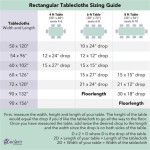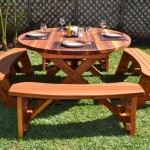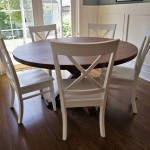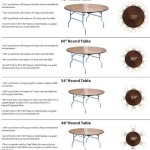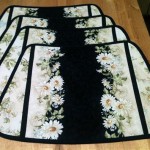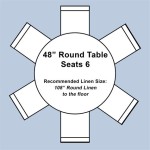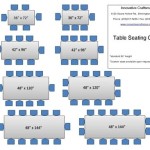How To Make A Simple Kitchen Table
Constructing a kitchen table can be a rewarding project for anyone looking to furnish their home with a personalized touch. This article outlines the process of building a simple, sturdy kitchen table, suitable for various dining spaces. The design emphasizes functionality and ease of construction, requiring basic woodworking skills and readily available materials.
Planning and Material Selection
The initial phase of constructing a kitchen table involves meticulous planning. The dimensions of the table must be determined based on the available space and the number of individuals it needs to accommodate. A standard kitchen table typically ranges from 30 to 36 inches in height. The length and width are contingent upon the intended seating capacity. A table designed for four people usually measures around 48 inches in length and 30 inches in width. For larger groups, these dimensions should be adjusted accordingly.
Once the dimensions are finalized, material selection becomes crucial. Solid wood is a common choice for kitchen tables due to its durability and aesthetic appeal. Popular options include pine, oak, maple, and cherry. Pine is often preferred for its affordability and ease of workability, while oak, maple, and cherry offer enhanced strength and a more refined appearance. The thickness of the wood also affects the table's sturdiness; a thickness of at least 1.5 inches is recommended for the tabletop to prevent warping or sagging.
In addition to the tabletop material, the selection of wood for the legs is equally important. The legs should be made from a hardwood like oak or maple to provide adequate support. The dimensions of the legs should be proportional to the size of the tabletop. Typically, legs that are 3 inches by 3 inches provide sufficient stability for a standard-sized kitchen table. Consider acquiring pre-made table legs from a woodworking supply store to simplify the construction process, ensuring uniformity and structural integrity.
Hardware requirements must also be considered during the planning phase. This includes screws, wood glue, and finishing products. The type of screws should be appropriate for the type of wood being used. Wood glue is essential for creating strong and durable joints. Finishing products, such as stain, varnish, or polyurethane, are used to protect the wood and enhance its appearance. Select finishing products that are food-safe, ensuring that the table surface is safe for dining.
Finally, gather all necessary tools. Essential tools include a circular saw or table saw for cutting the wood, a drill with various drill bits, a sander, clamps, a measuring tape, a square, safety glasses, and a dust mask. Having the right tools readily available will streamline the construction process and ensure accurate and safe execution.
Assembly of the Tabletop and Legs
The first step in assembly is preparing the tabletop. If using individual boards, they must be joined together to create a single, solid surface. This can be achieved using wood glue and clamps. Apply wood glue to the edges of the boards, and clamp them together tightly, ensuring they are flush and aligned. Allow the glue to dry completely, typically for at least 24 hours. Once the glue is dry, remove the clamps and sand the tabletop surface smooth, starting with a coarse grit sandpaper and progressing to a finer grit.
Next, construct aprons to connect the legs to the tabletop, adding stability and preventing warping. The aprons are typically made from the same material as the legs, cut to fit snugly between the legs and the tabletop. The aprons should be attached to the legs using wood glue and screws. Drill pilot holes before inserting the screws to prevent the wood from splitting. Ensure that the aprons are square, creating a stable and rigid frame.
Attaching the legs to the tabletop requires careful alignment. Invert the tabletop and position the leg frame underneath. The apron frame should be centered on the underside of the tabletop, leaving an equal overhang on all sides. Secure the apron frame to the tabletop using wood screws. Again, drill pilot holes to prevent splitting. Ensure that the screws are long enough to penetrate securely into the tabletop but not so long that they protrude through the surface.
Reinforcement can be added to the tabletop-leg connection for increased stability. Corner braces, often made of metal or wood, can be installed at the corners of the apron frame to provide additional support. These braces are screwed into both the apron frame and the tabletop, strengthening the joint and minimizing any potential movement.
Once the legs are securely attached, inspect the table for any wobbling or instability. If any wobble is detected, shim the legs as needed to ensure the table sits level. Small pieces of wood or plastic can be used as shims, placed under the feet of the legs until the table is stable.
Finishing and Protecting the Table
After the assembly is complete, the table requires finishing to protect the wood and enhance its appearance. The first step in finishing is sanding. Sand the entire table, including the tabletop, legs, and aprons, starting with a medium-grit sandpaper and progressing to a fine-grit sandpaper. This will create a smooth and even surface for the finish.
Once the table is sanded, remove all dust and debris. Use a tack cloth or a vacuum cleaner to ensure that the surface is clean and free of any particles that could interfere with the finish. Apply a wood conditioner to the table. A wood conditioner helps to even out the absorption of stain, preventing blotchiness and ensuring a consistent color.
Apply stain to the table if desired. Select a stain color that complements the surrounding décor. Apply the stain evenly using a brush or a rag, following the manufacturer's instructions. Allow the stain to penetrate for the recommended time, then wipe off any excess stain. Allow the stain to dry completely before proceeding to the next step.
Apply a clear coat finish to protect the table and enhance its durability. Polyurethane is a common choice for kitchen tables due to its resistance to water, scratches, and heat. Apply several thin coats of polyurethane, allowing each coat to dry completely before applying the next. Sand lightly between coats with a fine-grit sandpaper to create a smooth and even surface. Typically, two to three coats of polyurethane are sufficient to provide adequate protection.
For a more natural look, consider using a food-safe oil finish. Oil finishes penetrate the wood, providing protection from within. Apply several coats of oil finish, allowing each coat to soak in for a few minutes before wiping off the excess. Oil finishes require periodic reapplication to maintain their protective properties.
Once the finish is dry, inspect the table for any imperfections. Touch up any areas as needed. Apply felt pads to the bottom of the legs to protect the floor from scratches. The kitchen table is now complete and ready for use. Regular cleaning and maintenance will ensure that the table remains in good condition for years to come.

20 Gorgeous Diy Dining Table Ideas And Plans The House Of Wood
Wood Pallet Table Diy A Beautiful Mess

Diy Home Decor How To Make A Simple Modern Table Dining Furniture Kitchen

How To Make A Diy Farmhouse Dining Table Step By Guide Woodworking Engineer

Diy Scaffold Board Table And Bench Dining Simple With

Diy X Leg Farmhouse Table Liz Marie Blog

Monastery Dining Table Free Diy Plans Rogue Engineer

Remodelaholic Build A Farmhouse Table For Under 100 Diy Kitchen Dining Room

Diy X Leg Farmhouse Table Liz Marie Blog

Rustic X Dining Table And Bench Building Plan Remodelaholic
Related Posts

